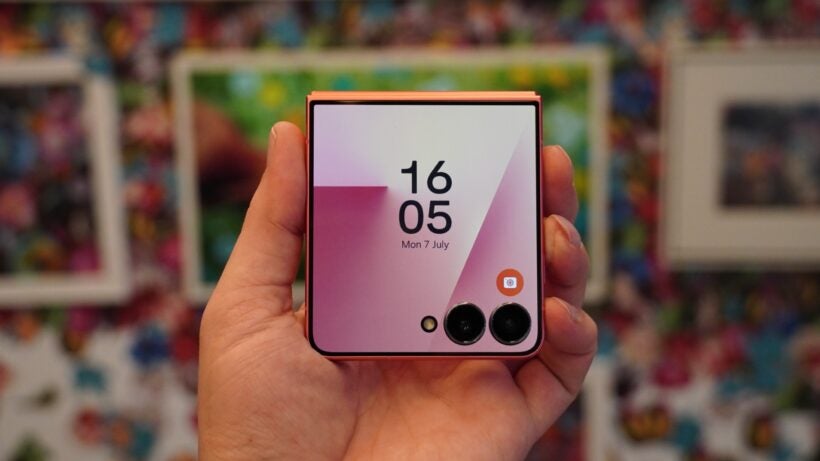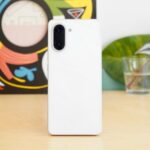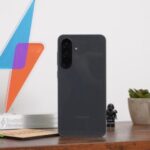
Key Features
-
Review Price: £1049 -
4.1-inch cover screen
With a large 4.1-inch cover screen and super slim bezels, it’s more useful than ever. -
Boosted battery life
The 4300mAh battery within the Flip 7 is the largest in any Flip to date, and should provide solid all-day battery life. -
Exynos 2500 chipset
Though not the top-end Snapdragon chipset, the Exynos 2500 should offer plenty of power for most users.
Introduction
After shipping with the same design and features for the past few years, the Samsung Galaxy Z Flip 7 is a breath of fresh air.
It’s not only thinner than its predecessor, but it also offers a spectacularly large, full-screen cover display that immediately makes it look more premium and futuristic, while also benefiting from a larger, wider internal screen as a result. It’s also more durable, offers a larger battery and sprinkles in a few Flip-exclusive camera features ideal for selfie takers and vloggers – all for the same price as the Z Flip 6.
While I’m not yet ready to deliver my final thoughts, I spent some time with the Galaxy Z Flip 7 at a hands-on event ahead of launch, so here’s what I think so far.
Design and screens
- Thinner than Z Flip 6
- Premium-looking 4.1-inch cover screen
- Larger, wider 6.9-inch internal screen
The star of Samsung’s foldable show may be the ultra-thin Galaxy Z Fold 7, but that doesn’t mean the flip-style Z Flip 7 hasn’t had any TLC.
Now it’s not quite as thin as the Fold 7, but Samsung has made strides to make this year’s foldable thinner at 6.5mm (unfolded), though at 188g, it’s a single gram heavier. Put it next to a Z Flip 6 and you’ll see that it is indeed 0.4mm thinner, but that might be a little harder to pick up on if you don’t have the two side-by-side.

Still, the slimmed-down design means that the Z Flip 7 remains a great phone to hold, both folded and unfolded, with the former now sitting slightly more comfortably in the palm of the hand.
It’s also more durable, using the same Armor FlexHinge tech from the Galaxy Z Fold 7, along with improved IP48 dust and water resistance that moves the waterproofing element from the bezels to the circuitry for even better resistance. That should give users added peace of mind, given the rather fragile reputation of foldables.
Now I’m somewhat burying the lede here, because the big thing about this year’s Flip isn’t how thin or light it is; it’s how big the cover screen has got.

Samsung has traditionally been a little late to the game when it comes to the outer screen; when competitors first moved to larger cover screens, the Flip stuck with its narrow, notification-focused pill screen. Then, once Samsung finally introduced slightly larger, more useful screens, the competition went full-screen. It was always one step behind.
Well, that’s no longer the case with the Z Flip 7, packing an exceptional 4.1-inch cover screen with super-slim 1.25mm-thick bezels that immediately give the foldable a much more premium look and feel. The larger size not only provides more space for your widgets, but with a Samsung Labs feature now offering the ability to run (almost) any app on the cover screen, it’s wholly more useful.

Unfold the phone and you’ll find a larger 6.9-inch Dynamic AMOLED 2X display, up from 6.7 inches last year, along with a slightly shorter and thicker 21:9 aspect ratio shouldn’t doesn’t make everything look quite as tall and narrow – especially in media-heavy apps – but I’ll have to confirm that once I spend more time with the foldable.
What’s more, much of the core spec is shared between both the internal and external panels; both offer a 120Hz refresh rate, AMOLED technology, and the same 2600nit peak brightness, ensuring a consistent overall experience.

There is still a crease visible, of course, but the new water droplet design of the hinge means it’s not quite as noticeable as it has been in the past. It’s still very much there, and slightly behind the Razr 60 Ultra to my eye, but it’s certainly an improvement.
Samsung has gone all-out on colour options this year, with particularly eye-catching shades of blue and red available alongside more understated jet black, with an exclusive Mint finish available via the Samsung Store.

It’s great to see such fun colours on a premium device, especially when Samsung’s flagship candybar phones are rather muted in comparison, and it allows the phone to stand out just as much as Motorola’s equally vibrant Razr 60 Ultra as a result.
Performance and software
- Exynos 2500 chipset
- Same camera hardware as Z Flip 6
- 4300mAh battery
Given that last year’s Z Flip 6 came with Qualcomm’s top-end Snapdragon 8 Gen 3, you might assume that this year’s model would feature the Snapdragon 8 Elite – but that’s not the case. For the first time, Samsung has introduced a split chipset, with only the big-screen Fold 7 getting the Qualcomm chip, with the Flip 7 instead getting Samsung’s own Exynos 2500.
I’ve not had a chance to benchmark the phone yet, so I can’t say with certainty how it performs compared to the Qualcomm chip, but given past performance comparing Samsung and QC chips, it’s likely that it’ll trail behind – especially with such massive gains from the 8 Elite compared to previous generations.

I can’t say I’m that fussed though; it makes more sense for the powerful chipset to be in the productivity-focused model, and during my hands-on time at least, the Exynos 2500 felt more than fast enough to deliver a super-smooth experience, especially when paired with 12GB of RAM.
In fact, it allows the Flip 7 to run DeX on larger screens for the first time – and that’s a win, if a somewhat niche one.

DeX support aside, the OneUI 8 that ships with the Z Flip 7 introduces a handful of improvements including a smarter Circle to Search experience that lets you get help in games, along with an optimised Gemini layout for the cover screen.
The latter should make it particularly easy to use the AI chatbot’s video capabilities, as you can prop the phone up at an angle and chat about what it sees.

Most of the new software features centre around the camera experience – one of the core tenets of the Flip 7. While the hardware remains identical to the Z Flip 6 – a 50MP main and 12MP ultrawide – the lenses now benefit from 10-bit HDR support for a boost to overall brightness and richness.
There are also improvements to the Portrait mode, with new fitlers that adapt to the lighting for natural selfies, along with real-time effect previews on the cover screen so you know exactly what you’re getting.
There’s also a handy new Auto Zoom tech that allows for hands-free shooting when in FlexCam mode (essentially when the phone is semi-folded on a table) by tracking your movements. Even taking photos and videos should be more straightforward, with a new coloured outline around the lenses on the cover screen whenever they’re active, giving selfie-takers somewhere to look.

Battery life, though not something I could really test during my short hands-on time with the phone, should also be better this year. The 4300mAh battery isn’t just the biggest in any Flip to date, but it’s only 100mAh behind the Fold 7 – though I expect that’s because the Fold has a lower capacity than it should, rather than the Flip 7 being exceptional.
Still, given my experience with the Flip 6, this should translate to a phone that’ll get you through a day without much complaint – but I’ll have to wait and see for now.
Final Thoughts
Though not quite as revolutionary an upgrade as the Z Fold 7, I think the Galaxy Z Flip 7 has enough to shout about. The larger cover screen, in particular, should make a huge difference to the Flip experience, allowing it to better compete with alternatives from Motorola and Xiaomi while adding a distinctly premium look to the foldable, which, dare I say, was missing before.
The lack of any camera hardware changes is a little disappointing to see, but the added camera features – from new filters to a new auto shooting mode – arguably cater more to the Flip user’s needs than a high-res zoom lens. This is a phone designed for selfie takers, after all, and I wager that the 50MP main camera will do just as good a job as ever at that.
Some might bemoan the use of the Exynos chipset, but I’d argue that flip-style foldables can rarely handle the thermals that come with top-end performance anyway, so for a less power-hungry user, it’s more than enough.
Combined, I think Samsung could really bring the fight to the Motorola Razr 60 Ultra – but I’ll reserve my final thoughts for once I’ve fully tested this year’s foldable.
Full Specs
| Samsung Galaxy Z Flip 7 Review | |
|---|---|
| UK RRP | £1049 |
| USA RRP | $1099 |
| Manufacturer | Samsung |
| Screen Size | 6.9 inches |
| Storage Capacity | 256GB, 512GB |
| Rear Camera | 50MP + 12MP |
| Front Camera | 10MP |
| Video Recording | Yes |
| IP rating | Not Disclosed |
| Battery | 4300 mAh |
| Fast Charging | Yes |
| Size (Dimensions) | 75.2 x 6.5 x 166.7 MM |
| Weight | 188 G |
| Operating System | OneUI 8 (Android 16) |
| Release Date | 2025 |
| First Reviewed Date | 09/07/2025 |
| Resolution | 2640 x 1080 |
| HDR | Yes |
| Refresh Rate | 120 Hz |
| Ports | USB-C |
| Chipset | Samsung Exynos 2500 |
| RAM | 12GB |
| Colours | Blue Shadow, Jet Black, Coral Red, Mint |



